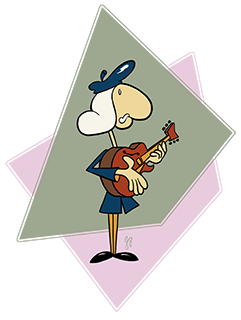This is a great exercise for people coming from a blues background trying to get a little jazz color in their playing. The exercise helps get the altered sounds into your ear, even though it is a little bit of a 'fudge.' Most importantly, it is focused on motif development rather than focusing on learning the shapes to play over each chord. Instead of trying to re-visualize your fretboard's landscape over every chord, this exercise focuses on making phrases that resolve, i.e. 'making music.'
It is not uncommon for blues players to move their 9th voicing (for example) up a half-step to reference the IV chord. That half-step sound is what a beginner should be looking for when they are trying to 'jazz' up their playing. If you play all the notes in this half step movement, you will feel how these notes compel you (lead you) to resolve back into the key. This is how jazz players think. The jazzbo is constantly introducing tension -- stretching a rubber band -- and then resolving, letting the rubber band come back to it's natural shape.
The ii-V-I is the progression to learn for jazz. In G the progression is A minor, D7, G major. If you line up all the notes in these chords, they are all in Gmaj. It's a 'diatonic' progression -- all the chords' notes are in the same key. However, true jazz players do a lot of stuff to build up their tension playing 'outside' Gmaj. I reality, it is more hip to play A minor, Ab7, Gmajor -- the tritone substitution. But let's simplify our ability to play this way without thinking to much.
The Exercise:
1) Play a simple phrase over the ii chord -- which is pretty much just a Dorian A minor -- the classic blues scale works.
2) Now repeat this phrase down a half-step.
3) Finally, resovle the phrase by ear.
Step one is the ii chord, step two is the five chord, step three is the one. The brilliance of this exercise is it forces you to make music more than learning scales and substitutions and theory. Practicing this helps you develop motifs, gets the altered sound in your ears, and helps you intuit where the leading tones resolve to G major.
There is a theoretical fudge to this exercise in that you are playing a minor on the five instead of a dominant. But don't get your hackles up over this as a beginner. Duke Ellington said, "If it sounds good, it is good." So try to make it sound good. One of the gems of this exercise is you are forced to listen to yourself in the context of the progression. You are listening to what you are playing because you have to repeat your own phrase. You are not 'coloring by numbers,' but getting involved with what you are creating.
Bonus Exercise:
1) Play a simple phrase over the ii chord (again just a blues pentatonic or dorian phrase in Aminor will work).
2) Repeat the phrase a minor third up (that's three frets or semi-tones).
3) Resolve to G major by ear.
To recap -- you are playing something melodic, committing it to memory and repeating it three frets up, then finding a note to answer in the G major scale.
Here you are essentially playing the iv minor (C-) in step two. Some people call iv- the 'important' chord. The iv minor always wants to resolve to the one. Now you have a whole harmonic substitution added to your vocabulary. Try substituting the iv- in place of your five while comping.
Double Bonus Exercise:
Now let's actually play a REAL tritone substitution to get the most tension-resolution out of our line -- let's really stretch the rubber-band. Traditionally we say the tritone is Amin, Ab7, Gmaj. But what is Ab7 -- just Ebmin with a differnt root! The tritone is actually 2 minor thirds up from the one chord.
1) Play a minor phrase over the ii chord.
2) Repeat the phrase 2 minor thirds up (Eb for resolving to Gmaj).
3) Resolve to the root major by ear.
With these three exercises, you've just increased your ii-V-I vocabulary about 400%!
In the Guitarwank podcast, Bruce refers to a youtube video where Josh Smith attempts to explain the same material that Bruce taught him. I believe that video is here. Even if you are a seasoned jazzbo -- try these exercises out. You'll be glad you did.

 RSS Feed
RSS Feed
